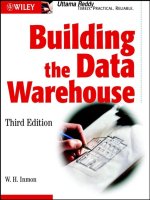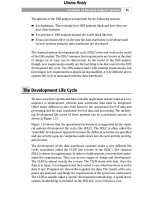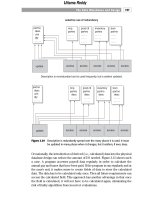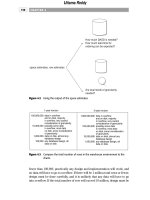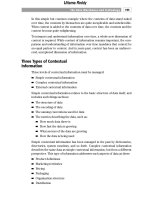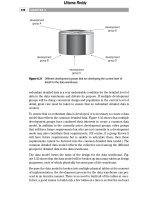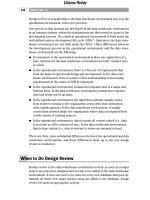Building the Data Warehouse Third Edition phần 10 potx
Bạn đang xem bản rút gọn của tài liệu. Xem và tải ngay bản đầy đủ của tài liệu tại đây (482.21 KB, 41 trang )
■■
Aging populated data (i.e., running tallying summary programs)
■■
Managing multiple levels of granularity
■■
Refreshing living sample data (if living sample tables have been built)
The output of this step is a populated, functional data warehouse.
PARAMETERS OF SUCCESS: When done properly, the result is an accessi-
ble, comprehensible warehouse that serves the needs of the DSS community.
HEURISTIC PROCESSING—METH 3
The third phase of development in the architected environment is the usage of
data warehouse data for the purpose of analysis. Once the data in the data
warehouse environment is populated, usage may commence.
There are several essential differences between the development that occurs at
this level and development in other parts of the environment. The first major
difference is that at this phase the development process always starts with data,
that is, the data in the data warehouse. The second difference is that require-
ments are not known at the start of the development process. The third differ-
ence (which is really a byproduct of the first two factors) is that processing is
done in a very iterative, heuristic fashion. In other types of development, there
APPENDIX
365
DSS5
subject
area
DSS7
source
system
analysis
DSS8
specs
DSS9
programming
DSS10
population
data model
analysis
DSS1
breadbox
analysis
DSS2
data warehouse
database design
DSS6
technical
assessment
DSS3
technical
environment
preparation
DSS4
for each subject
Figure A.2 METH 2.
Uttama Reddy
is always a certain amount of iteration. But in the DSS component of develop-
ment that occurs after the data warehouse is developed, the whole nature of
iteration changes. Iteration of processing is a normal and essential part of the
analytical development process, much more so than it is elsewhere.
The steps taken in the DSS development components can be divided into two
categories-the repetitively occurring analysis (sometimes called the “depart-
mental” or “functional” analysis) and the true heuristic processing (the “indi-
vidual” level).
Figure A.3 shows the steps of development to be taken after the data ware-
house has begun to be populated.
HEURISTIC DSS DEVELOPMENT—METH 4
DEPT1-Repeat Standard Development-For repetitive analytical processing
(usually called delivering standard reports), the normal requirements-driven
processing occurs. This means that the following steps (described earlier) are
repeated:
M1—interviews, data gathering, JAD, strategic plan, existing systems
APPENDIX
366
IND2
program to
extract data
IND4
analyze data
IND5
answer
question
IND3
program to
merge,
analyze,
combine with
other data
determine data
needed
IND1
for each analysis
IND6
institutionalize?
– for departmental,
repetitive reports
– for heuristic analytical
processing
standard requirements
development for reports
DEPT1
Figure A.3 METH 3.
Uttama Reddy
M2—sizing, phasing
M3—requirements formalization
P1—functional decomposition
P2—context level 0
P3—context level 1-n
P4—dfd for each component
P5—algorithmic specification; performance analysis
P6—pseudocode
P7—coding
P8—walkthrough
P9—compilation
P10—testing
P11—implementation
In addition, at least part of the following will occur at the appropriate time:
GA1—high-level review
GA2—design review
It does not make sense to do the data analysis component of development
because the developer is working from the data warehouse.
The output of this activity are reports that are produced on a regular basis.
PARAMETERS OF SUCCESS: When done properly, this step ensures that
regular report needs are met. These needs usually include the following:
■■
Regulatory reports
■■
Accounting reports
■■
Key factor indicator reports
■■
Marketing reports
■■
Sales reports
Information needs that are predictable and repetitive are met by this function.
NOTE: For highly iterative processing, there are parameters of success, but
they are met collectively by the process. Because requirements are not defined
a priori, the parameters of success for each iteration are somewhat subjective.
APPENDIX
367
Uttama Reddy
IND1—Determine Data Needed
At this point, data in the data warehouse is selected for potential usage in the
satisfaction of reporting requirements. While the developer works from an edu-
cated-guess perspective, it is understood that the first two or three times this
activity is initiated, only some of the needed data will be retrieved.
The output from this activity is data selected for further analysis.
IND2—Program to Extract Data
Once the data for analytical processing is selected, the next step is to write a
program to access and strip the data. The program written should be able to be
modified easily because it is anticipated that the program will be run, modified,
then rerun on numerous occasions.
DELIVERABLE: Data pulled from the warehouse for DSS analysis.
IND3—Combine, Merge, Analyze
After data has been selected, it is prepared for analysis. Often this means edit-
ing the data, combining it with other data, and refining it.
Like all other heuristic processes, it is anticipated that this program be written
so that it is easily modifiable and able to be rerun quickly. The output of this
activity is data fully usable for analysis.
DELIVERABLE: Analysis with other relevant data.
IND4—Analyze Data
Once data has been selected and prepared, the question is “Do the results
obtained meet the needs of the analyst?” If the results are not met, another iter-
ation occurs. If the results are met, then the final report preparation is begun.
DELIVERABLE: Fulfilled requirements.
IND5—Answer Question
The final report that is produced is often the result of many iterations of pro-
cessing. Very seldom is the final conclusion the result of a single iteration of
analysis.
APPENDIX
368
TEAMFLY
Team-Fly
®
Uttama Reddy
IND6—Institutionalization
The final issue to be decided is whether the final report that has been created
should be institutionalized. If there is a need to run the report repetitively, it
makes sense to submit the report as a set of requirements and to rebuild the
report as a regularly occurring operation.
Summary
How the different activities relate to each other and to the notion of data archi-
tecture are described by the diagram shown in Figure A.4.
Selected Topics
The best way to describe the data-driven nature of the development methodol-
ogy is graphically. Figure A.5 shows that the data model is at the heart of the
data-driven methodology.
The data model relates to the design of operational data, to the design of data in
the data warehouse, to the development and design process for operational
data, and to the development and design process for the data warehouse. Fig-
ure A.5 shows how the same data model relates to each of those activities and
databases.
The data model is the key to identifying commonality across applications. But
one might ask, “Isn’t it important to recognize the commonality of processing as
well?”
The answer is that, of course, it is important to recognize the commonality of
processing across applications. But there are several problems with trying to
focus on the commonality of processes-processes change much more rapidly
than data, processes tend to mix common and unique processing so tightly that
they are often inseparable, and classical process analysis often places an artifi-
cially small boundary on the scope of the design. Data is inherently more stable
than processing. The scope of a data analysis is easier to enlarge than the scope
of a process model. Therefore, focusing on data as the keystone for recognizing
commonality makes sense. In addition, the assumption is made that if com-
monality of data is discovered, the discovery will lead to a corresponding com-
monality of processing.
For these reasons, the data model-which cuts across all applications and
reflects the corporate perspective-is the foundation for identifying and unifying
commonality of data and processing.
APPENDIX
369
Uttama Reddy
APPENDIX
370
context level
pseudocod
P
DIS
context level
data store
definition
design
review
requirements
formalization
context level 1-n
DFD (for each component)
algorithmic specs;
performance analysis
coding
walkthrough
compilation
testing
implementation
P1
P3
P4
P5
P7
P8
P9
P10
P11
PREQ1
M3
D2
D3
JA1
P2
ERD
D1
high level
review
GA1
physical
database
design
D4
pseudocode
P6
GA2
M mainline
PREQ prerequisite
D data analysis
P process analysis
GA general activity
JA joint activity
ST stress test
CA capacity analysis
f
o
r
e
a
c
h
p
r
o
c
e
s
s
f
o
r
e
a
c
h
s
u
b
j
e
c
t
M4
interviews
data gathering
JAD sessions
strategic plan
existing systems
M1
M2
use existing
code, data
capacity
analysis
CA
stress test
ST
technical
environment
established
sizing,
phasing
context level 0
functional
decomposition
performance
analysis
DSS5
subject
area
DSS7
source
system
analysis
DSS8
specs
DSS9
programming
DSS10
population
data model
analysis
DSS1
breadbox
analysis
DSS2
data warehouse
database design
DSS6
technical
assessment
DSS3
technical
environment
preparation
DSS4
for each subject
Operational Sector
DATA-DRIVEN DEVELOPMENT METHODOLOGY
DSS Sector
Departmental
IND2
program to
extract data
IND4
analyze data
IND5
answer
question
IND3
program to
merge,
analyze,
combine with
other data
determine data
needed
IND1
for each analysis
IND6
institutionalize?
– for departmental,
repetitive reports
– for heuristic analytical
processing
standard requirements
development for reports
DEPT1
Data Warehouse
Uttama Reddy
APPENDIX
371
Individual Data
• nonrepetitive
• temporary
• ad hoc
• PC oriented
• heuristic
• analytical
• mostly derived data
• limited amounts of data
• no update of data
Departmental Data
• repetitive
• parochial
• summarizations, subsets
• mixture of primitive and derived
• parochially managed databases
• trend analysis, demographic
analysis, exception reporting,
monthly key figures, etc.
marketing
engineering
accounting
Data Warehouse
• integrated data
• a perspective over time
• no update, load only
• no online access, batch only
• subject oriented
• different levels of granularity
• can contain external data
• mostly primitive, with some public
derived data
• nonredundant
• as detailed data over time
• sometimes called “atomic” data
bank officer
transaction
account
customer
Operational Data
• built application by application
• current value data
• data can be updated
• online, transaction oriented
savings
CDs
loans
bank
card
DATA ARCHITECTURE
Figure A.4
METH 4. Data-Driven development methodology.
Uttama Reddy
APPENDIX
372
Data Warehouse
• integrated data
• a perspective over time
• no update, load only
• no online access, batch only
• subject oriented
• different levels of granularity
• can contain external data
• mostly primitive, with some public
derived data
• nonredundant
• as detailed data over time
• sometimes called “atomic” data
bank officer
transaction
account
customer
Operational Data
• built application by application
• current value data
• data can be updated
• online, transaction oriented
savings
CDs
loans
bank
card
data model
context level
pseudocod
P
DIS
context level
data store
definition
design
review
requirements
formalization
context level 1-n
DFD (for each component)
algorithmic specs;
performance analysis
coding
walkthrough
compilation
testing
implementation
P1
P3
P4
P5
P7
P8
P9
P10
P11
PREQ1
M3
D2
D3
JA1
P2
ERD
D1
high level
review
GA1
physical
database
design
D4
pseudocode
P6
GA2
M mainline
PREQ prerequisite
D data analysis
P process analysis
GA general activity
JA joint activity
ST stress test
CA capacity analysis
f
o
r
e
a
c
h
p
r
o
c
e
s
s
f
o
r
e
a
c
h
s
u
b
j
e
c
t
M4
interviews
data gathering
JAD sessions
strategic plan
existing systems
M1
M2
use existing
code, data
capacity
analysis
CA
stress test
ST
technical
environment
established
sizing,
phasing
context level 0
functional
decomposition
performance
analysis
DSS5
subject
area
DSS7
source
system
analysis
DSS8
specs
DSS9
programming
DSS10
population
data model
analysis
DSS1
breadbox
analysis
DSS2
data warehouse
database design
DSS6
technical
assessment
DSS3
technical
environment
preparation
DSS4
for each subject
Figure A.5
METH 5.
Uttama Reddy
APPENDIX
373
Deliverables
The steps of the data-driven development methodology include a deliverable. In
truth, some steps contribute to a deliverable with other steps. For the most
part, however, each step of the methodology has its own unique deliverable.
The deliverables of the process analysis component of the development of
operational systems are shown by Figure A.6.
Figure A.6 shows that the deliverable for the interview and data-gathering
process is a raw set of systems requirements. The analysis to determine what
code/data can be reused and the step for sizing/phasing the raw requirements
contribute a deliverable describing the phases of development.
The activity of requirements formalization produces (not surprisingly) a formal
set of system specifications. The result of the functional decomposition activi-
ties is the deliverable of a complete functional decomposition.
The deliverable for the dfd definition is a set of dfds that describe the functions
that have been decomposed. In general, the dfds represent the primitive level of
decomposition.
The activity of coding produces the deliverable of programs. And finally, the
activity of implementation produces a completed system.
The deliverables for data analysis for operational systems are shown in Figure
A.7.
The same deliverables discussed earlier are produced by the interview and data
gathering process, the sizing and phasing activity, and the definition of formal
requirements.
The deliverable of the ERD activity is the identification of the major subject
areas and their relationship to each other. The deliverable of the dis activity is
the fully attributed and normalized description of each subject area. The final
deliverable of physical database design is the actual table or database design,
ready to be defined to the database management system(s).
The deliverables of the data warehouse development effort are shown in Figure
A.8, where the result of the breadbox analysis is the granularity and volume
analysis. The deliverable associated with data warehouse database design is
the physical design of data warehouse tables. The deliverable associated with
technical environment preparation is the establishment of the technical envi-
ronment in which the data warehouse will exist. Note that this environment
may or may not be the same environment in which operational systems exist.
Uttama Reddy
APPENDIX
374
P4
DFD (for each component)
P5
algorithmic specs;
performance analysis
P6
pseudocode
P7
coding
P8
walkthrough
P9
compilation
P10
testing
P11
implementation
M1
• interviews
• data gathering
• JAD sessions
• strategic plan
• existing systems
M2
use existing code, data
M3
sizing, phasing
M4
requirements formalization
P1
functional decomposition
P2
context level 0
P3
context level 1-n
raw system
requirements
phases of
development
formal requirements
complete functional
decomposition
DFDs
programs
completed system
Figure A.6 METH 6. Deliverables throughout the development life cycle.
Uttama Reddy
APPENDIX
375
On a repetitive basis, the deliverables of data warehouse population activities
are represented by Figure A.9, which shows that the deliverable for subject
area analysis-each time the data warehouse is to be populated-is the selection
of a subject (or possibly a subset of a subject) for population.
The deliverable for source system analysis is the identification of the system of
record for the subject area being considered. The deliverable for the program-
D4
physical database design
M1
• interviews
• data gathering
• JAD sessions
• strategic plan
• existing systems
M2
use existing code, data
M3
sizing, phasing
M4
requirements formalization
D1
ERD
D2
DIS
D3
performance analysis
raw system
requirements
phases of
development
formal requirements
midlevel detailed data
model
major subject areas
tables, databases
physically designed
Figure A.7 METH 7. Deliverables for operational data analysis.
Uttama Reddy
APPENDIX
376
ming phase is the programs that will extract, integrate, and change data from
current value to time variant.
breadbox analysis
DSS2
granularity analysis
technical environment
preparation
DSS4
DSS technical
environment ready
for loading
data warehouse
database design
physical database
design
DSS6
Figure A.8 METH 8. Preliminary data warehouse deliverables.
subject
area
DSS5
source
system
analysis
DSS7
specs
DSS8
programming
DSS9
population
DSS10
which
subject
area to
build
identification of
the system of
record
extract,
integration, time
basis, program
transformation
usable data
warehouse
Figure A.9 METH 9. Deliverables from the steps of data warehouse development.
Uttama Reddy
APPENDIX
377
The final deliverable in the population of the data warehouse is the actual pop-
ulation of the warehouse. It is noted that the population of data into the ware-
house is an ongoing activity.
Deliverables for the heuristic levels of processing are not as easy to define as
they are for the operational and data warehouse levels of development. The
heuristic nature of the analytical processing in this phase is much more infor-
mal. However, Figure A.10 shows some of the deliverables associated with
heuristic processing based on the data warehouse.
Figure A.10 shows that data pulled from the warehouse is the result of the
extraction program. The deliverable of the subsequent analysis step is further
analysis based on data already refined. The deliverable of the final analysis of
data is the satisfaction (and understanding) of requirements.
A Linear Flow of Deliverables
Except for heuristic processing, a linear flow of deliverables is to be expected.
Figure A.11 shows a sample of deliverables that would result from the execu-
tion of the process analysis component of the data-driven development
methodology.
It is true that within reason there is a linear flow of deliverables; however, the
linear flow shown glosses over two important aspects:
determine
data needed
IND1
program to
extract data
IND2
analyze data
IND4
fulfilled
requirements
data pulled
from the
warehouse
program to
merge, analyze,
combine with
other data
analysis with
other relevant
data
IND3
Figure A.10 METH 10. Deliverables for the heuristic level of processing.
Uttama Reddy
APPENDIX
378
■■
The deliverables are usually produced in an iterative fashion.
■■
There are multiple deliverables at any given level. In other words, deliver-
ables at any one level have the capability of spawning multiple deliverables
at the next lower level, as shown by Figure A.12.
Figure A.12 shows that a single requirements definition results in three devel-
opment phases. Each development phase goes through formal requirements
definition and into decomposition. From the decomposition, multiple activities
are identified, each of which has a dfd created for it. In turn, each dfd creates
one or more programs. Ultimately, the programs form the backbone of the com-
pleted system.
completed system
raw system
requirements
phases of
development
formal
requirements
complete functional
decomposition
DFDs
programs
Figure A.11 METH 11. A linear flow of deliverables for operational process analysis.
TEAMFLY
Team-Fly
®
Uttama Reddy
APPENDIX
379
Estimating Resources Required for
Development
Looking at the diagram shown in Figure A.12, it becomes apparent that once the
specifics of exactly how many deliverables are being spawned are designed,
then an estimation of how many resources the development process will take
can be rationally done.
Figure A.13 shows a simple technique, in which each level of deliverables first
is defined so that the total number of deliverables is known. Then the time
raw system
requirements
phases of
development
formal
requirements
complete functional
decomposition
DFDs
programs
completed system
Figure A.12 METH 12. Deliverables usually spawn multiple deliverables at a lower level.
Uttama Reddy
APPENDIX
380
required for the building of each deliverable is multiplied by each deliverable,
yielding an estimate of the employee resources required.
SDLC/CLDS
Earlier discussions alluded to the fact that operational systems are built under
one system development life cycle, and DSS systems are built under another
system development life cycle. Figure A.14 shows the development life cycle
associated with operational systems, where requirements are at the starting
point. The next activities include analysis, design, programming, testing, inte-
gration, implementation, and maintenance.
The system development life cycle associated with DSS systems is shown by
Figure A.15, where DSS processing begins with data. Once data for analysis is
secured (usually by using the data warehouse), programming, analysis, and so
forth continue. The development life cycle for DSS data ends with an under-
standing of the requirements.
no del × del = _______
no del × del = _______
no del × del = _______
no del × del = _______
no del × del = _______
no del × del = _______
Figure A.13 METH 13. stimating system development time.
Uttama Reddy
APPENDIX
381
context level
pseudocod
P
DIS
context level
data store
definition
design
review
requirements
formalization
context level 1-
n
DFD (for each component)
algorithmic specs;
performance analysis
coding
walkthrough
compilation
testing
implementation
P1
P3
P4
P5
P7
P8
P9
P10
P11
PREQ1
M3
D2
D3
JA1
P2
ERD
D1
high level
review
GA1
physical
database
design
D4
pseudocode
P6
GA2
M mainline
PREQ prerequisite
D data analysis
P process analysis
GA general activity
JA joint activity
ST stress test
CA capacity analysis
f
o
r
e
a
c
h
p
r
o
c
e
s
s
f
o
r
e
a
c
h
s
u
b
j
e
c
t
M4
interviews
data gathering
JAD sessions
strategic plan
existing systems
M1
M2
use existing
code, data
capacity
analysis
CA
stress test
ST
technical
environment
established
sizing,
phasing
context level 0
functional
decomposition
performance
analysis
requirements
analysis
design
programming
testing
integration
implementation
maintenance
the classical system development lifecycle
Figure A.14 METH 14.
Uttama Reddy
APPENDIX
383
The data dictionary plays a central role in operational processing in the activi-
ties of ERD development and documentation, DIS development, physical data-
base design, and coding. The data dictionary plays a heavy role in data model
analysis, subject area selection, source system selection (system of record
identification), and programming in the world of data warehouse development.
What about Existing Systems?
In very few cases is development done freshly with no backlog of existing sys-
tems. Existing systems certainly present no problem to the DSS component of
the data-driven development methodology. Finding the system of record in
existing systems to serve as a basis for warehouse data is a normal event.
data
model
analysis
subject
area
source
system
analysis
specs
programming
ERD
DIS
performance
analysis
physical
database
design
pseudocode
coding
data dictionary
operational
development
the role of the data dictionary
in the development process
for data-driven development
Figure A.16 METH 16. Data warhouse development.
Uttama Reddy
APPENDIX
384
A word needs to be said about existing systems in the operational environment.
The first approach to existing operational systems is to try to build on them.
When this is possible, much productivity is the result. But in many cases exist-
ing operational systems cannot be built on.
The second stance is to try to modify existing operational systems. In some
cases, this is a possibility; in most cases, it is not.
The third stance is to do a wholesale replacement and enhancement of existing
operational systems. In this case, the existing operational system serves as a
basis for gathering requirements, and no more.
A variant of a wholesale replacement is the conversion of some or all of an
existing operational system. This approach works on a limited basis, where the
existing system is small and simple. The larger and more complex the existing
operational system, the less likelihood that the system can be converted.
Uttama Reddy
Installing Custom Controls
385
GLOSSARY
access the operation of seeking, reading, or writing data on a storage unit.
access method a technique used to transfer a physical record from or to a
mass storage device.
access pattern the general sequence in which the data structure is accessed
(for example, from tuple to tuple, from record to record, from segment to seg-
ment, etc.).
accuracy a qualitative assessment of freedom from error or a quantitative
measure of the magnitude of error, expressed as a function of relative error.
ad hoc processing one-time-only, casual access and manipulation of data on
parameters never before used, usually done in a heuristic, iterative manner.
after image the snapshot of data placed on a log on the completion of a
transaction.
agent of change a motivating force large enough not to be denied, usually
aging of systems, changes in technology, radical changes in requirements, etc.
algorithm a set of statements organized to solve a problem in a finite number
of steps.
alternate storage storage other than disk-based storage used to hold bulk
amounts of relatively inactive storage.
385
Uttama Reddy
analytical processing using the computer to produce an analysis for man-
agement decision, usually involving trend analysis, drill-down analysis, demo-
graphic analysis, profiling, etc.
application a group of algorithms and data interlinked to support an organi-
zational requirement.
application database a collection of data organized to support a specific
application.
archival database a collection of data containing data of a historical nature.
As a rule, archival data cannot be updated. Each unit of archival data is relevant
to a moment in time, now passed.
artifact a design technique used to represent referential integrity in the DSS
environment.
atomic (1) data stored in a data warehouse; (2) the lowest level of process
analysis.
atomic database a database made up of primarily atomic data; a data ware-
house; a DSS foundation database.
atomic-level data data with the lowest level of granularity. Atomic-level data
sits in a data warehouse and is time-variant (i.e., accurate as of some moment
in time now passed).
attribute a property that can assume values for entities or relationships.
Entities can be assigned several attributes (for example, a tuple in a relation-
ship consists of values). Some systems also allow relationships to have attrib-
utes as well.
audit trail data that is available to trace activity, usually update activity.
backup a file serving as a basis for the activity of backing up a database. Usu-
ally a snapshot of a database as of some previous moment in time.
batch computer environment in which programs (usually long-running,
sequentially oriented) access data exclusively, and user interaction is not
allowed while the activity is occurring.
batch environment a sequentially dominated mode of processing; in batch,
input is collected and stored for future, later processing. Once collected, the
batch input is transacted sequentially against one or more databases.
before image a snapshot of a record prior to update, usually placed on an
activity log.
bitmap a specialized form of an index indicating the existence or nonexis-
tence of a condition for a group of blocks or records. Bitmaps are expensive to
build and maintain but provide very fast comparison and access facilities.
GLOSSARY
386
Uttama Reddy
blocking the combining of two or more physical records so that they are
physically located together. The result of their physical colocation is that they
can be accessed and fetched by a single execution of a machine instruction.
cache a buffer usually built and maintained at the device level. Retrieving
data out of a cache is much quicker than retrieving data out of a cylinder.
cardinality (of a relation) the number of tuples (i.e., rows) in a relation.
CASE computer-aided software engineering
checkpoint an identified snapshot of the database or a point at which the
transactions against the database have been frozen or have been quiesced.
checkpoint/restart a means of restarting a program at some point other
than the beginning for example, when a failure or interruption has occurred. N
checkpoints may be used at intervals throughout an application program. At
each of those points, sufficient information is stored to permit the program to
be restored to the moment in time the checkpoint has been taken.
CLDS the facetiously named system development life cycle for analytical,
DSS systems. CLDS is so named because, in fact, it is the reverse of the classi-
cal systems development life cycle SDLC.
clickstream data data generated in the Web environment that tracks the
activity of the users of the Web site.
column a vertical table in which values are selected from the same domain. A
row is made up of one or more columns.
Common Business Oriented Language (COBOL) a computer language
for the business world. A very common language.
commonality of data similar or identical data that occurs in different appli-
cations or systems. The recognition and management of commonality of data is
one of the foundations of conceptual and physical database design.
compaction a technique for reducing the number of bits required to repre-
sent data without losing the content of the data. With compaction, repetitive
data are represented very concisely.
condensation the process of reducing the volume of data managed without
reducing the logical consistency of the data. Condensation is essentially differ-
ent from compaction.
contention the condition that occurs when two or more programs try to
access the same data at the same time.
continuous time span data data organized so that a continuous definition
of data over a span of time is represented by one or more records.
GLOSSARY
387
Uttama Reddy
corporate information factory (CIF) the framework that exists that sur-
rounds the data warehouse; typically contains an ODS, a data warehouse, data
marts, DSS applications, exploration warehouses, data mining warehouses,
alternate storage, and so forth
CPU central processing unit.
CPU-bound the state of processing in which the computer can produce no
more output because the CPU portion of the processor is being used at 100 per-
cent capacity. When the computer is CPU-bound, typically the memory and
storage processing units are less than 100 percent utilized. With modern DBMS,
it is much more likely that the computer is I/O-bound, rather than CPU-bound.
CRM customer relationship management, a popular DSS application
designed to streamline customer/corporate relationships.
cross-media storage manager software whose purpose is to move data to
and from disk storage and alternate storage.
current value data data whose accuracy is valid as of the moment of execu-
tion, as opposed to time-variant data.
DASD see direct access storage device.
data a recording of facts, concepts, or instructions on a storage medium for
communication, retrieval, and processing by automatic means and presenta-
tion as information that is understandable by human beings.
data administrator (DA) the individual or organization responsible for the
specification, acquisition, and maintenance of data management software and
the design, validation, and security of files or databases. The data model and
the data dictionary are classically the charge of the DA.
database a collection of interrelated data stored (often with controlled, lim-
ited redundancy) according to a schema. A database can serve single or multi-
ple applications.
database administrator (DBA) the organizational function charged with
the day-to-day monitoring and care of the databases. The DBA function is more
closely associated with physical database design than the DA is.
database key a unique value that exists for each record in a database. The
value is often indexed, although it can be randomized or hashed.
database management system (DBMS) a computer-based software sys-
tem used to establish and manage data.
data-driven development the approach to development that centers
around identifying the commonality of data through a data model and building
programs that have a broader scope than the immediate application. Data-
driven development differs from classical application-oriented development.
GLOSSARY
388
Uttama Reddy
data element (1) an attribute of an entity; (2) a uniquely named and well-
defined category of data that consists of data items and that is included in a
record of an activity.
data item set (dis) a grouping of data items, each of which directly relates
to the key of the grouping of data in which the data items reside. The data item
set is found in the midlevel model.
data mart a departmentalized structure of data feeding from the data
warehouse where data is denormalized based on the department’s need for
information.
data mining the process of analyzing large amounts of data in search of pre-
viously undiscovered business patterns.
data model (1) the logical data structures, including operations and con-
straints provided by a DBMS for effective database processing; (2) the system
used for the representation of data (for example, the ERD or relational model).
data structure a logical relationship among data elements that is designed
to support specific data manipulation functions (trees, lists, and tables).
data warehouse a collection of integrated, subject-oriented databases
designed to support the DSS function, where each unit of data is relevant to
some moment in time. The data warehouse contains atomic data and lightly
summarized data.
decision support system (DSS) a system used to support managerial deci-
sions. Usually DSS involves the analysis of many units of data in a heuristic
fashion. As a rule, DSS processing does not involve the update of data.
decompaction the opposite of compaction; once data is stored in a com-
pacted form, it must be decompacted to be used.
denormalization the technique of placing normalized data in a physical loca-
tion that optimizes the performance of the system.
derived data data whose existence depends on two or more occurrences of
a major subject of the enterprise.
derived data element a data element that is not necessarily stored but that
can be generated when needed (age, current date, date of birth).
design review the quality assurance process in which all aspects of a system
are reviewed publicly prior to the striking of code.
dimension table the place where extraneous data that relates to a fact table
is placed in a multidimensional table.
direct access retrieval or storage of data by reference to its location on a vol-
ume. The access mechanism goes directly to the data in question, as is generally
required with online use of data. Also called random access or hashed access.
GLOSSARY
389
TEAMFLY
Team-Fly
®
Uttama Reddy
direct access storage device (DASD) a data storage unit on which data
can be accessed directly without having to progress through a serial file such as
a magnetic tape file. A disk unit is a direct access storage device.
dormant data data that is very infrequently used.
download the stripping of data from one database to another based on the
content of data found in the first database.
drill-down analysis the type of analysis where examination of a summary
number leads to the exploration of the components of the sum.
DSS application an application whose foundation of data is the data ware-
house.
dual database the practice of separating high-performance, transaction-
oriented data from decision support data.
dual database management systems the practice of using multiple data-
base management systems to control different aspects of the database environ-
ment.
dumb terminal a device used to interact directly with the end user where all
processing is done on a remote computer. A dumb terminal acts as a device that
gathers data and displays data only.
estetbusiness commerce conducted based on Web interactions.
encoding a shortening or abbreviation of the physical representation of a
data value (e.g., male ϭ “M,” female ϭ “F”).
enterprise resource planning (ERP) application software for processing
transactions.
entity a person, place, or thing of interest to the data modeler at the highest
level of abstraction.
entity-relationship diagram (ERD) a high-level data model; the schematic
showing all the entities within the scope of integration and the direct relation-
ship between those entities.
event a signal that an activity of significance has occurred. An event is noted
by the information system.
Executive Information Systems (EIS) systems designed for the top exec-
utive, featuring drill-down analysis and trend analysis.
extract/load/transformation (ETL) the process of taking legacy applica-
tion data and integrating it into the data warehouse.
external data (1) data originating from other than the operational systems
of a corporation; (2) data residing outside the central processing complex.
GLOSSARY
390
Uttama Reddy

